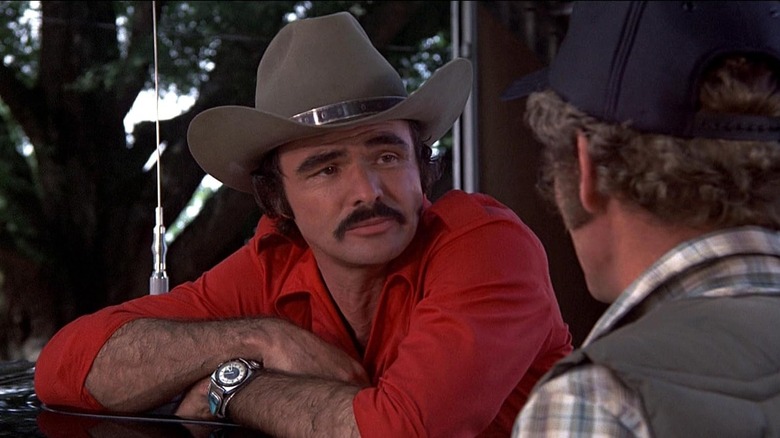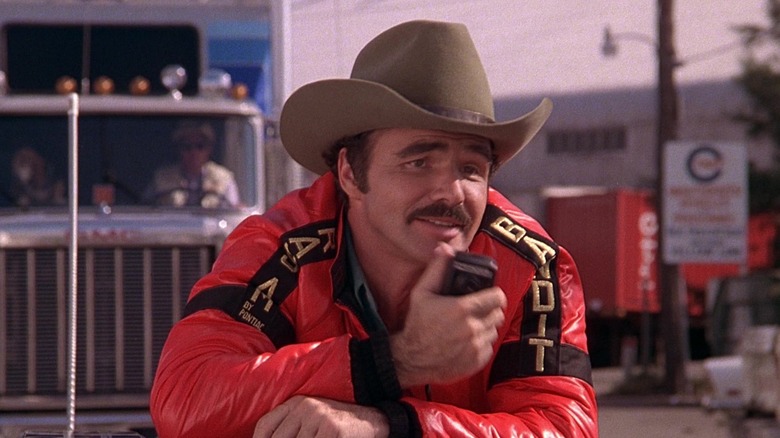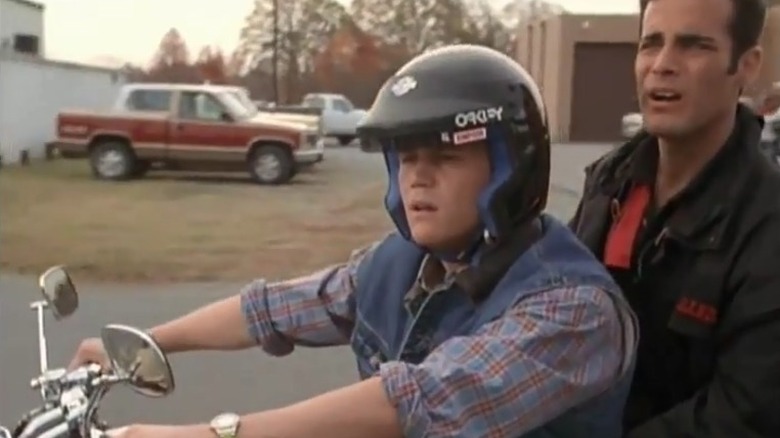Burt Reynolds' Most Beloved Movie Spawned A High-Speed '80s Franchise
Everyone can name the highest-grossing film of 1977 — George Lucas' "Star Wars: Episode IV — A New Hope" — as it kicked off a high-profile sci-fi franchise that persists to this day. Other big hits from that year included Steven Spielberg's alien abduction thriller "Close Encounters of the Third Kind" (a movie inspired by Spielberg's real-life fascination with alien life) and John Badham's downbeat disco drama "Saturday Night Fever" (a film that John Travolta trained "Rocky"-style to prepare for). One of the more notable yet less-discussed success stories of 1977, however, was Hal Needham's laidback beer-run action-comedy "Smokey and the Bandit," a film that raked in roughly $127 million at the box office against a $4.3 million budget. That's like a $23 million movie earning $677 million in 2025.
"Smokey and the Bandit" is a playfully rebellious film about a Southern sports car owner, nicknamed Bandit (Burt Reynolds), who is tasked by a pair of benefactors (Pat McCormick and Paul Williams) with retrieving a truck full of beer. Bandit lives in a dry county, however, so making a beer run is risky. Indeed, he ends up attracting the ire of local Sheriff Buford T. "Smokey" Justice (Jackie Gleason). Bandit also falls in with Carrie (Sally Field), and the two share an instant chemistry. Bandit is in a hurry, but not so much that he can't stop and have a playful/romantic chat with Carrie.
Given how casual and easygoing "Smokey and the Bandit" is, it's surprising that it was such a hit. But there was something about Reynolds' charm, his fast car, and his devil-may-care philosophy that drew people in. It helped that Reynolds and Field had such great chemistry (they were an item in real life at the time) and that Gleason had created such an indelible character.
And like "Star Wars," it also spawned a long-running franchise.
There are several Smokey and the Bandit movies
"Smokey and the Bandit," like "Star Wars," got a direct sequel in 1980, although "Smokey and the Bandit II" wasn't nearly as big a hit as "Star Wars: Episode V — The Empire Strikes Back" (itself the first Harrison Ford film the star was happy with). Needham returned to direct with Field once again co-starring, although she and Reynolds broke up shortly after production wrapped, so the romantic chemistry isn't quite as palpable this time. Also, the plot is sillier. In the movie, Bandit has turned to the bottle after breaking up with Carrie, so part of the runtime is devoted to getting him sober again. He and his partner Cledus (Jerry Reed) are then tasked with transporting an elephant to the nearby Republican National Convention. With Smokey on their tail, Bandit, Cledus, and Carrie all head to Dallas. The film is a little more nonsensical than its predecessor, so one can see why it was less successful. At least Gleason got to ham it up by playing three different characters.
After that, the "Smokey" movies swerved off the rails with the 1983 sequel "Smokey and the Bandit Part 3" (aka simply "Smokey and the Bandit III"). Hardly anyone liked the film, which Reynolds is barely in. Instead, the movie follows Smokey as he's offered a great sum to drive a shark statue across state lines. Hoping he will lose, his benefactors hire Cledus to disguise himself as the Bandit (!) and try to trip him up. Reynolds himself only appears in a single scene near the end, at which point Smokey has a hallucination. Critics hated it at the time and the film is still reviled to this day. Everyone kind of already knew "Smokey and the Bandit" had a thin premise anyway, so making multiple sequels was never a good idea.
"Smokey and the Bandit Part 3" went on to gross a puny $7 million on a $9 million budget. But if you thought that would be the end of the line for the franchise, you'd be wrong.
Smokey and the Bandit lived on as a series of TV movies in the 1990s
In 1994, the "Smokey and the Bandit" property was resurrected in the form of four TV movies, all starring Brian Bloom as the Bandit. The events of these TV films seem to only be semi-canonical, as there's no Smokey character looming over the proceedings. Instead, the movies play like extended episodes in a "Renegade"-style TV series wherein Bandit travels the American South hoping to aid people in trouble. Hal Needham returned to direct all four of the movies, and they star a panoply of recognizable 1990s actors.
The first movie, "Bandit Goes Country," stars country star Mel Tillis as himself. When Bandit helps him after a plane crash, the pair become friends, only to see their newfound relationship jeopardized when Bandit's cousin (Christopher Atkins) bootlegs Mel's music. Confusingly, the second film, which is amusingly titled "Bandit Bandit," then features a Bandit imposter played by Gerard Christopher. (Since these movies were sold under the banner title of "Bandit," technically the movie is called "Bandit: Bandit Bandit.") After that comes the third flick, "Beauty and the Bandit," which starred supermodel Kathy Ireland as a woman on the run from a gangster played by Tony Curtis. Finally, the fourth film, "Bandit's Silver Angel," starred Traci Lords as the eponymous angel, with Donald O'Connor playing Bandit's elderly uncle.
Like the films that inspired them, the "Bandit" TV movies are weirdly laidback. At the same time, TV writing of the 1990s dictated these things have actual stories, so the films are comparatively cogent and structured, at least from a writing perspective. They're certainly a sight better than "Smokey and the Bandit Part 3," anyway.
Nowadays, "Smokey and the Bandit," unlike "Star Wars," doesn't have yearly celebrations, cults of merch collectors, or entire online enclaves picking apart its plot fineries. But it was another significant hit from 1977 that lived on for a very long time. Give it some respect.


